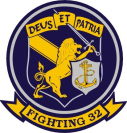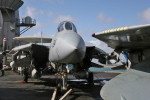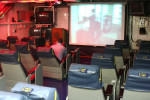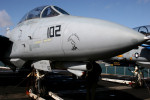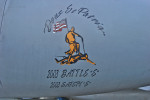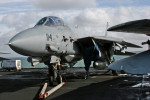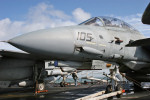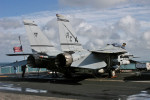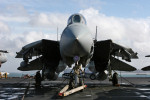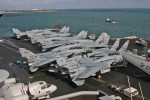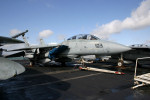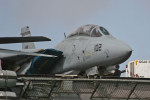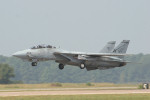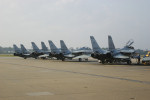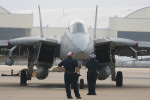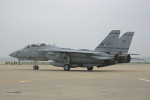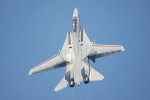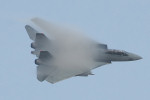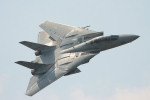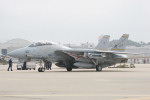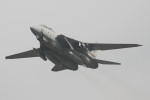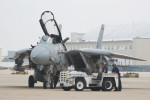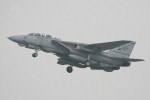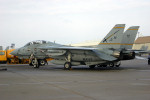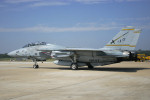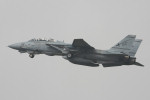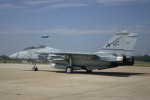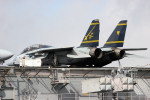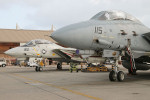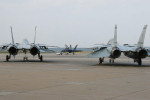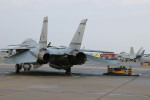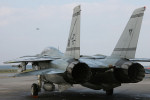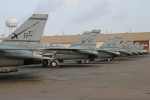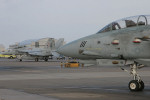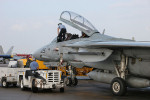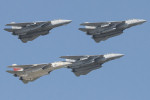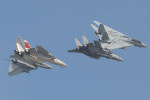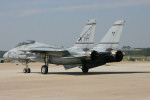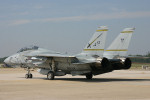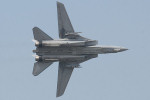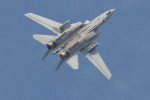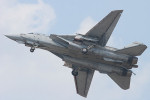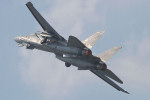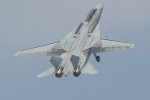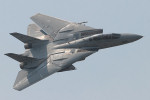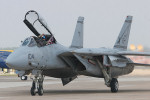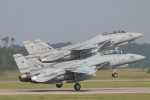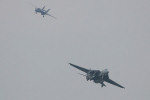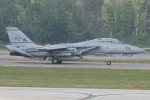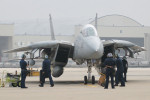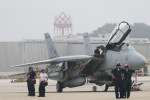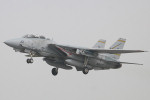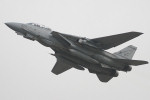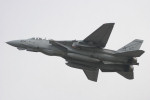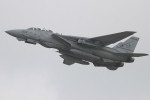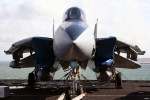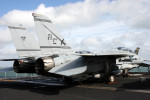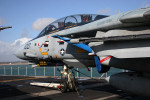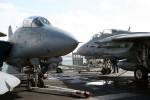Following in the recent footsteps of VFA-11 and VFA-143, this change makes the Swordsmen the latest unit to swap their ageing F-14B Tomcats for the latest in US Navy airpower – the Super Hornet and, like VFA-11, the Swordsmen will be getting twin-seat F/A-18Fs. Over the years, thirty-two fleet fighter units have flown the ‘Cat and during the mid to late 80s, all units were still in existance, yet now only two Tomcat units remain – VF-31 Tomcatters and VF-213 Black Lions, both flying the last incarnation of the mighty Cat... the F-14D. Their Cats are slightly different to previous Ds as VF-31 and VF-213 both have Cats that have recently been cleared to employ the 500lb GBU-38 JDAM. Both squadrons are currently assigned to CVW-8 and embarked aboard the USS Theodore Roosevelt conducting missions in support of ongoing operations in Iraq & Afghanistan and Maritime Security Operations in the Persian Gulf. |
|
|
VF-32
started life way back on 1 February 1945 when VF-3 split to form two
sister units – VF-3 and VBF-3. Just nine days after VBF-3s official
stand-up, the Crazy Cats and their F6F “Dash 5”
Hellcats were assigned to Carrier Air Group 3 and sent to sea aboard
the 27,000t Essex-class USS Yorktown. About a week later, Crazy Cat
pilots of Flight 2-A became not just the first ever USN pilots but the
first ever fighter pilots to bomb targets on mainland Japan. A year
later and, following a transition onto the bubble-canopied F8F-1 Bearcat,
VBF-3 was redesignated as VF-4A. It wasn’t until a further redesignation
in August 1948 that they were to become VF-32. Their first taste of
combat as VF-32 came in 1950 in the Korean War whilst embarked on the
USS Leyte (officially a long-hull Ticonderoga-class carrier) - the embarked
airwing managed to rack up more than 11,000 flight hours. During their
May 1950 to February 1951 association with the Leyte, VF-32s F4U-4s
flew alongside VF-31s F9F-2 Panthers – the slower precursor to
the swept-wing J48-engined F9F-6 Cougar that VF-32 would soon transition
onto when they returned home. In doing so, VF-32 became the first operators
of the Cougar. Unlike the older and slower Panther, the Cougars couldn’t
be outclassed by MiG-15 Fagots but they made it into service too late
to see action in the Korean War. |
Following
a handful of deployments with the Cougar, the squadron swapped their
aircraft yet again - this time to become the USNs first supersonic squadron
with the J57-powered Vought F8U-1 Crusader. VF-32 re-equipped with the
Crusader at NAS Cecil Field, Florida in March 1957 and in early 1958
became the first front line unit to operate a Crusader from a carrier
when they embarked on the USS Saratoga for a Mediterranean cruise (the
first Pacific Fleet deployment of the Crusader was with VF-154 aboard
the USS Hancock about a fortnight after VF-32 took their F8U-1s to sea).
During this cruise, the Saratoga’s first with Sixth Fleet, her
airwing and that embarked on the USS Essex flew long range air-cover
missions in support of Operation BLUE BAT - the amphibious landing of
Marines in Beirut to secure the airport, the port and approaches to
the city and to provide support for the Lebanese against internal uprising
and threats from Syria and Egypt. |
|
|
Following
the introduction of the Tri-Service designation scheme in 1962, the
F8U-1 became the F-8A. Later that year, VF-32 once again went to sea
aboard the Saratoga (and yet again alongside VF-31, but the Tomcatters
were now flying F-3B Demons) for a Caribbean cruise but this time with
the F-8D derivative of the Crusader - the all-weather interceptor variant.
The Mach 1.7 Crusader was the last American fighter which employed guns
as the primary armament and the reason the Crusader became known as
The Last of the Gunfighters. In 1965, VF-32 moved homebase
from NAS Cecil Field to NAS Oceana and re-equipped with F-4B Phantoms
which signalled the end of their partnership with the Saratoga. Their
first Toom cruise was as part of CVW-1 aboard USS Franklin D. Roosevelt
which took them to war over Vietnam alongside the F-4B-equipped VF-14
and three A-4 light attack units. This South East Asia cruise ended
in February 1967, only for CVW-1 and CV-42 to be redeployed to the Mediterranean
for a nearly eight month cruise from August of that same year. In early
1969, VF-32 and CVW-1 embarked on the brand new USS John F Kennedy for
her maiden Mediterranean cruise that lasted nearly nine months. VF-32s
last cruise as an F-4 unit was in 1973 and in the four years between
had seen the Caribbean, Mediterranean and North Atlantic. VF-32 had
also been on the JFK for her first visit to a North Atlantic port when
she visited Edinburgh. |
Seven
months later, in July 1974, VF-32 left the F-4 behind for pastures new.
These new pastures would involve twin tails and swing wings. Beaten
to the new toy by VF-1, VF-2 and VF-14 (their F-4B counterparts on the
Roosevelt), they undertook their first CARQUALs (CARrier QUALifications)
using USS Kitty Hawk during December of 1974 and then February and March
of 1975. In June 1975, now with two F-14 units assigned, CVW-1 returned
to the decks of JFK for a Mediterranean cruise taking them into early
1976. On this, their very first Cat cruise, they were awarded the Clifton
Award to mark their position as the Navy's top fighter squadron and
in 1977 became the first F-14 unit to go toe-to-toe with USAF F-15s
in Dissimilar Air Combat Training. Less than a year later, VF-32 became
the first unit to test the F-14s TV Camera System and were the first
unit to deploy with the AIM-9L for fleet captive carriage trials. During
this 1978 cruise, VF-32 also took part in BUZZARDEX, a mid-cruise missile
exercise, that saw them launch AIM-7F Sparrow and AIM-54A Pheonix missiles
against five Mach 2.5 targets. The fifteen year relationship with CVW-1
came to an end in March 1981 following the end of the last VF-32/CVW-1
Med cruise; fifteen months later VF-32 were at sea again but as part
of CVW-6 (still alongside VF-14) on the USS Independence. Three cruises
with the Indy saw VF-32 take in the sights and sounds in the
Mediterranean, North Atlantic, Caribbean and even the Indian Ocean as
CV-62 swapped homeports from Norfolk to San Diego (with LANTFLTs CVW-6
being replaced by PACFLTs CVW-14). During these cruises, CVW-6 aircraft
were involved in providing air support for peacekeepers in Lebanon,
Operation URGENT FURY (the liberation of Grenada) and even launched
strikes against Syrian positions when they got back in the Med after
the trip out to Grenada. |
|
|
August
1986 saw the Kennedy get “her” airwing back after spending
the winter of 1984 in drydock, but yet again there was to be a shuffle
of air wings - VF-14 and VF-32s new home was CVW-3. JFK was deployed
to the Med until March 1987 and following a nearly 18-month break was
redeployed back to the region in August 1988. It is on this cruise that
VF-32 crews once again had a taste of combat. Way back in 1981, Libya
decided that the entire Gulf of Sidra was theirs and basically increased
the territorial waters claim. The US were somewhat unhappy with this
and to challenge it routinely put carrier battle groups just over twelves
miles off the Libyan coast. Aircraft from the carriers often broke into
these “territorial waters” and were tracked by Libyan radar.
Libyan jets were also sent up to “intercept” with the normal
course of events being the aircraft turning away and going home. 19
August 1981 would be different – two Libyan Su-22s sent up to
intercept two VF-41 F-14As on CAP from the Nimitz got creative. They
fired upon the Tomcats, permission was given to engage and the two Su-22s
never went home. |
Less
than eight years later, on 4 January 1989, two VF-32 F-14As took off
from the JFK for a routine CAP. Two MiG-23 Floggers were then detected
and noted to be on an intercept course. Common practice at the time
was to lock on to the Libyan jets with the massively powerful AWG-9
radar giving the Libyans time (or should that be notice?) to turn round
and go home. Either these Libyan pilots were brave or stupid as they
just kept coming and eventually engaged the Swordsmen duo. Following
evasive action from the pair of Tomcats and the clear intentions the
Libyans were sending out by trying to maintain a position from which
to fire, the MiG-23s were declared hostile and the Tomcats were cleared
to fire. From then on, there was only going to be one outcome. The first
AIM-7 shot from the lead F-14 (AC-202) missed – AC-207 fired an
AIM-7 and brought down one Flogger. The sole remaining Flogger was engaged
by the lead Tomcat and an AIM-9 was sent up the tailpipe. Result? The
Libyan Air Force were another two jets down. |
|
|
Returning home in early 1989 and following some work in the Norfolk shipyard, JFK took part in New York’s Fleet Week 1990 and was in Boston for the July 4th Independence Day celebrations; roughly one month later JFK and CVW-3 were back at sea for Desert Shield. On the way to the western Mediterranean, VF-14 and VF-32 Tomcats took advantage of the proximity to Cyprus to conduct ops against the Akrotiri based RAF Phantoms. Arriving in the Red Sea in September 1990, JFK became the flagship of Commander, Red Sea Battle Group which comprised the Kennedy, Saratoga, America and Theodore Roosevelt. During the early hours of 16 January 1991, Desert Shield changed into Desert Storm and CVW-3 (with two A-7E units on their last cruise) launched air strikes against Iraqi targets. CVW-3 aircraft spent more than 11,000 hours in the air, conducted nearly 10,500 arrested landings from 12,300 launches, flew nearly 2,900 sorties and delivered nearly 1600 tonnes of ordnance on 114 strikes with no loss to man or machine. Furthermore, a VF-32 crew had the distinction of being the last US Navy crew over Baghdad. Whether it's a good thing or a bad thing, the Tomcat force never increased the kill tally and were left with one or two mission types - escorting the strike packages and TARPS (Tactical Airborne Reconnaissance Pod System) equipped reconnaissance. At that time, the pod was “wet film” – digital solutions were just not available – yet Navy personnel once managed to get TARPS imagery developed from the film in less than 13 minutes after the jet landed!! The entire Tomcat force flew 781 TARPS missions. |
After
four months in dock for repairs, maintenance and much needed engineering
work to allow the A-7E to be replaced by the F/A-18, CVW-3 were back
in the Med (for the fourteenth time) – being more precise, the
Adriatic Sea - in late 1992 through to early 1993 and provided support
for UN forces involved in Operation Provide Promise in Bosnia. Early
on in this cruise, arrested landing number 250000 was chalked up. It
is on this cruise that VF-32 first became a "strikefighter"
unit and flew many missions against ground targets. When the JFK returned
home, she entered a two-year overhaul programme leaving CVW-3 without
a ship from which to fly! In October 1994, CVW-3 found a new, albeit
temporary, home in the Nimitz-class carrier USS Dwight D. Eisenhower
(CVN-69) and departed for a six-month cruise in support of Operations
Southern Watch, Deny Flight, Vigilant Warrior, Provide Promise (again)
and Sharp Guard. This short month-long deployment was also the first
time women formed part of the personnel on a US Navy combatant –
400 women were assigned to CVN-69, CVW-3 and COMCRUDESGRU-8. VF-32 also
first started wearing 100-series Modexes on this cruise, after having
worn 200-series Modexes for all its active life except the 1953-1954
World Cruise on USS Tarawa. |
|
|
When
Ike returned home in July 1995, she went in for an 18-month COH so VF-32
was to embark on yet another carrier – the pick this time was
USS Theodore Roosevelt (CVN-71). CVW-3 was embarked, devoid of VA-75
and their A-6Es – Hornets were the order of the day this time
round. Another important change to take place was that VF-32 was now
no longer an F-14A unit – they had re-equipped with the more efficient,
more powerful F-14B. CVW-3 then spent the six months or so leading up
to late May 1997 launching missions in support of Southern Watch and
Deliberate Guard. During this deployment, VF-32 became only the second
squadron to take LANTIRN capable F-14s to sea and the first time digital
TARPS was employed – the previous wet film versions meant the
aircraft actually had to return for the film to be developed; the new
Pulnix digital camera (replacing the KS-97) meant that commanders and
other F-14s in a strike package had near real-time imagery at ranges
of up to 300km. The major advantage is that soon after the F-14 flies
over a target, the commanders back on the carrier or ashore can identify
and classify the target – and potentially authorise a strike against
it before the person inside or the vehicle has chance to move. Ike wasn’t
home to CVW-3 for long and in November 1998, CVW-3 embarked aboard the
USS Enterprise (CVN-65) for a six month cruise that saw them participate
in Southern Watch and Desert Fox after relieving USS Theodore Roosevelt.
Between the 16th and 19th of December, VF-32 dropped more than 50 tonnes
of precision guided ordnance in just 16 missions - an average of more
than 3 tonnes per mission. In line with VF-32s penchant for being the
first to do things, this cruise was no different - VF-32 F-14Bs were: - the first USN platform to drop a 2,000-lb GBU-24 Paveway III in combat - the first ever platform to drop multiple GBU-24s in combat - first to use the LANTIRN targetting pod in combat - first to use the automated delivery mode of the GBU-10/16 Paveway II (2,000lb and 1,000lb respectively) and GBU-24. |
In
late 2000, CVW-3 embarked on the Navy’s latest and greatest Nimitz-class
democracy tool – USS Harry S. Truman (CVN-75) for her maiden voyage
to the Mediterranean and Persian Gulf during which CVW-3 supported Southern
Watch and took part in Exercise Arabian Gauntlet. Following a successful
and incident free maiden cruise, she returned to Norfolk before conducting
a week of operations just off the east coast of the USA. September 2002
was the COMPUTEX, prior to the JTFEX in very late October and the first
week of November. About a month later, CVW-3 were off on another cruise
to the Med. This particular cruise meant CVW-3 crews would be involved
in the war against terror in Enduring Freedom and Iraqi Freedom –
not to mention the additional and on-going support of Southern Watch.
At the start of combat operations, VF-32 had undertaken JDAM and LGB
strikes against fixed targets and were arguably the longest of the war
- because of diplomatic "problems", the first mission flown
saw the strike package of Tomcats and Hornets have to traverse 1,400
miles as they had to fly from the Western Mediterranean, down the Sinai
Peninsula, across Saudi Arabia and into Iraq. After these "conventional"
missions, VF-32 were then dedicated to providing CAS for special forces
in Western Iraq. In yet another first for the squadron, VF-32 crews
routinely trained with three 2,000lb JDAMs - until this, no other unit
had ever flown the Tomcat with more than two of the 2,000lb weapons
and VF-32 became the first (there's that word again!) fighter squadron
to release multiple JDAMs. |
|
|
During
Iraqi Freedom, VF-32 flew daytime missions with the F-14Ds of VF-213
assigned to CVW-8 on the USS Theodore Roosevelt being part of the designated
night air wing so therefore were to fly with at night and with NVGs
- thanks to this day wing and night wing approach, VF-32 and VF-213
were able to provide almost non-stop 24-hour air support to the special
forces. When CVW-3 and CVW-8 ended their combat operations in mid April,
the twenty Tomcats on Truman and Roosevelt had used nearly 300 tonnes
of ordnance - VF-32 went to war with just fourteen crews who had managed
to chalk up 275 combat sorties with 1247 hours in the air and had used
118 JDAMs, nearly 250 LGBs and more than a thousand rounds of 20mm HE
incendiary rounds. Perhaps even more eye opening is the effort that
the VF-32 personnel put in - their "in the background" work
meant that they managed a 100% sortie completion rate. Whilst
out in the Persian Gulf VF-32 also participated in NEON FALCON - an
annual Bahraini exercise - and conducted various air-to-air missions
against Bahraini F-5s and F-16s of the 1st TFW from Shaikh Isa AB. On
their way home, personnel got some well deserved time ashore in France,
Italy, Greece, Slovenia and Portsmouth. |
CVW-3 returned home in May 2003 but not before VF-32 tried something not attempted since 1972 and never on an operational squadron - the launching of six AIM-54 Phoenix missiles. From one jet. Declared a success, the single jet managed to launch five of the six missiles. After returning home, Truman went to NGNN in August for a six month long upgrade/repair program before VF-32s final cruise in October 2004. This cruise, taking the Truman back to the Middle East to support OEF/OIF was sadly VF-32s last ever cruise with the Tomcat. During the four months in theatre, VF-32 typically flew eight "in country" missions every day with each mission lasting no less than 5.5 hours and needing three trips to the USAF KC-135s and KC-10s for refuelling. Each section (one VF-32 F-14B and one VMFA-115 F/A-18C) was assigned a specific area of Iraq and were mostly working with Marine ground units, with the odd Army unit too. If needed, the ground units asked VF-32 to take a closer look at "interesting" subjects with the onboard sensor systems or to perform low-level flypasts for a show of force. The last resort was to drop ordnance - and in 1,120 missions, of which 413 were "combat", totalling more than 3,000 hours flightime just 21 tonnes of ordnance (each jet usually carried two 500lb GBU-12 Paveway II LGBs plus the Vulcan cannon) was dropped on Iraqi positions. Their deployment meant they were in theatre in the lead-up to the first ever democratic Iraqi elections for more than 50 years and to help encourage people out to vote, missions often meant there was quite a bit of low flying over Iraqi villages to let them know there was still a coalition presence. |
|
|
As
CVW-8s VF-31 and VF-213 were at sea on the Roosevelt, Tomcat participation
at the NAS Oceana 2005 show fell solely on the shoulders of The Swordsmen;
the VF-101 retro jet (AD-160) was to be used for the Sunday display
but officially VF-101 The Grim Reapers had been disbanded on
the Thursday before the show. It's safe to say the Gypsies did themselves
proud - the often overlooked maintainers ensured jets were available
and in good condition for their "Final Gypsy Roll". For the
very last time ever, Oceana saw four F-14s in the Fleet Flyby and Airfield
Attack - plus the last EVER F-14 Tacdemo and without the help of VF-32,
Oceana would not have had any flying Tomcats. A VF-32 linejet (AC-104)
was the mount of Rocco and Smokin' Joe on Saturday
with VF-101s retro jet getting the honours on Sunday. Sadly VF-32s retro
jet, Gypsy 112, remained on the flight line and didn't make it into
the show proper. Almost as soon as the show was over, that was pretty
much it as far as VF-32 go. AC-112 was sent to AMARC and various
other airframes were sent to numerous musuems. |
|
Unlike
most other squadrons that have moved onto the new Super Hornet, The
Swordsmen have the luxury of being able to transition at their home
base of NAS Oceana thanks to VFA-106 Gladiators - the sole East Coast
Hornet/Super Hornet Fleet Replacement Squadron. Previously, transitioning
units have had to temporarily move to NAS Lemoore in California to train
under VFA-122 - and often just after returning home from a stressing
six month cruise. Starting last month, VF-32 aircrew were split into
two classes and they began (the second class started their course two
weeks after the first) a four month long intensive Category 2 training
syllabus at VFA-106 (Category 2 is for fleet experienced crews, Category
1 would be for aircrews that have never been in a fleet squadron). During
the course, the aircrews are expected to have 176.2 hours of "classroom"
time, 82.3 hours in the simulators and 220.9 hours flying time in VFA-106
jets. The ordnance, avionics and electrician shops will get a longer,
6 month course - everyone else gets 3~4 months. In late spring, the
squadron will reform from their various courses and achieve "safe
for flight" status which proves they can operate independently
- they can they receive their full complement of their own jets and
once again do whatever needs to be done, whenever it needs to be done. |
|
| Deus et Patria |
| The author would like to thank LT Ashley "Ciao" Augostini for her great help in compiling this article. |

